#Gipsy Woman
Explore tagged Tumblr posts
Text
youtube
Gipsy Woman - The Soul Throbs (Millie Come Back, 1975)
#Soul#Soul Music#Soul Music Songs#Music#Music Songs#The Soul Throbs#Millie Come Back#1975#Soul Soul#Gipsy Woman#Youtube
1 note
·
View note
Text

💃 Esmeralda from The Hunchback of Notre Dame 🕺
#ai#ai art#ai artwork#ai girl#ai sexy#ai woman#the hunchback of notre dame#esmeralda#disney#disney art#disney movies#beautiful#pretty#cute#gipsy#emerald eyes
6 notes
·
View notes
Text
「Astrology: What Men find attractive」


A man with Moon in Aries likes brave, strong, capable women subconsciously seeking a leader in her; Venus in Aries provides preference for women with crew-cut who go in for sports, are slightly muscular, skinny and even bony. Such man also likes a woman to “ get “ him.
A man with Moon in Taurus likes affluent women, good cooks, women who are thrifty and who economise; with Venus in Taurus he likes plump women with pronounced feminine characteristics, courting takes place over a good meal without fail…
A man with the Moon in Gemini likes talkative, intelligent women, he goes for a “ good conversation”, likes women who look and act young and enjoy going for a spin and short trips. Venus in Gemini produces preferences for women of a very narrow waist, fine hands and shoulders …
A man with the Moon in Cancer likes women who cry easily, are stay-at-home types, good housewives and subconsciously, in a woman he seeks his mother. Venus in Cancer expresses preferences for nice breasts, provocative cleavage and likes to see his woman looking nice even at home.
A man with Moon in Leo likes successful women in high places from well-known and reputable families, he likes to be proud of his wife. Venus in Leo – a woman must be dressed exceptionally well as if she was about to take part in a beauty contest …
A man with the Moon in Virgo likes diligent women, pedantic and neat, the ones who take care of their husband’s health …Venus in Virgo provides special liking for sexy belly button, fine tummy and ordinary clothes…
A man with the Moon in Libra likes sweet and good-looking women, models, politicians, lawyers, women active in public life. With Venus in Libra he is very much receptive to women’s buttocks …
A man with the Moon in Scorpio likes women who came into a property of some kind, women with pronounced sex appeal who do not hide their charms, women whose looks and appearance imply “ a straightforward offer “…With Venus in Scorpio he likes see-through dressing style and goes for gipsy music …
The Moon in Sagittarius produces a man with a special liking for women who follow the fashion and in their appearance resemble the women from foreign countries; he likes educated women with university degree who go in for sports, especially tennis … Venus in Sagittarius makes him responsive to long legs, short skirts, shorts …
A man with the Moon in Capricorn goes for a darker complexion, dark-haired women of a serious and even melancholic expression; he also likes older women…Venus in Capricorn produces liking for conventional clothing style, women wearing leather and dressed in darker shades.
A man with the Moon in Aquarius likes outgoing women; his motto is “ friends first, relationship later “, he likes intelligent women …With Venus in Aquarius he likes eccentric-looking women of an eccentric style, is responsive to women’s legs, and especially calves.
A man with the Moon in Pisces likes mysterious, withrawn, shy women who always seem as if they are in need of protection…Venus in Pisces produces liking for fine stockings, shoes, lingerie …
What’s your opinion🤔✨?
If you want to support this blog as well as my research there’s a Tip option in the bio. Or CashApp me £astroroyale .This way I can keep posting high quality content for you as it encourages me in the process <3 :) Thank you & Much love
Original article link, by Nikola Stojanovic
#astrology notes#astrology observations#astrology#astro community#aries#pisces#gemini#taurus#cancer#leo zodiac#virgo#libra#scorpio#sagittarius#aquarius#capricorn#horoscope#moon signs#venus signs
1K notes
·
View notes
Text
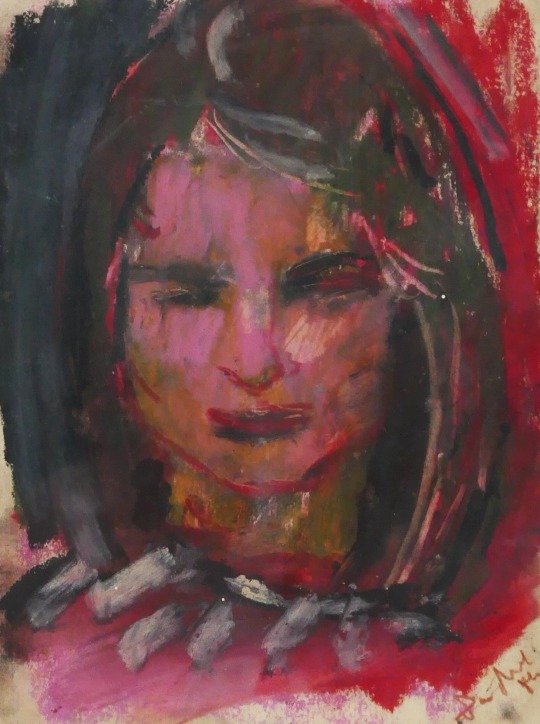
Virgiliu Parghel (Romanian, b. 1954), Gipsy Woman. Mixed technique, 23.5 x 17cm
85 notes
·
View notes
Note
So I found a weird potion and a strange powder in the attic of my gipsy grandma's house with some weird instructions: "take a drop of the pink potion, and your size will be reduced till you weigh 100 grams (any more drops wil reduce the weight by another tenfold) . Then take a pinch of powder and bake it into any dish you like. Eat that entire dish and you become your regular size again." I showed this to my wife and she wanted to try it immediately. I gave her a single drop and her size reduced to a cm or 15 tall. We checked her weight and she really was a 100 grams! I baked her a single cupcake with the powder in it to return her to her former size. She ate it like a woman posessed. I could hear from her small voice that it was the best thing she had ever eaten. After what seemed like less than a minute the cupcake was gone and she started growing back again. When she started growing though, it seemed like she was gaining weight at a rapid rate. That's when I realized the mistake i made; when she was smaller, she basically ate a cupcake that was the weight as she was, meaning she became twice as heavy when she grew! I apologized profusely, but she was ecstatic. The feeling of her body growing was orgasmic bliss to her (and to be fair, she wears it well). She wanted to do it again immediately, but I had my doubts. So she explained to me that she always had a bit of a fat fetish, but her metabolism left her petite and very thin and now she had a way to make her dreams come true and then some. So after a lovely night in the bedroom she convinced met to help her gain even more weight with the potion and the powder. Now my question is: should I take it slow and just make the same sized cupcake, doubling her weight each time, or should I size it all up? Let her have more drops so the cupcakes are bigger in comparison? Bake bigger cakes or even a tub full of just batter? Or should I just give her the bottle entirely and drop her reducing body in the nation's ice cream reserve while just a pinch of powder gets mixed into it? What is a husband to do to please his wife?
Hey, honestly that ask on its own is basically its own post and it's like you've done my job for me! Well not job, this is supposed to just be a hobby to make people happy, but you get what I mean!
Hard to EXPAND on that much unfortunately as you've made such a good description yourself...maybe you should take up writing on a blog as well! Who knows, you definitely have talent~ <3
Anyway...
The best course of action is doing whatever makes your wife happier. Now, she's obviously fat, and fattening up at a rate where she's very unlikely to lose all her weight, unless you find another special potion for weight loss specifically, in your grandma's attic or somewhere else. She is definitely VERY into this, and so should you, there's so much more of her to love~! If you DID have access to the national ice cream reserve...what's there to stop you, or even her to do such a thing? She might start taking the initiative herself even when you're not looking or away from home, ending up fatter and fatter each time you arrive, so you might as well go all in with every option you just said, combined.
Drop the whole liquid on her, put powder on the largest food container you can find, have her tiny, almost inaudible moans and squeals show the pleasure she's having eating so much for her tiny body (even if frankly she's eating so much that even if she was at her normal self she'd be more than bloated!) that'll soon become a gigantic blob that's definitely visible from space, the most grandious, beautiful, ginormous, titanic wife ever...
A hungry blob that'll demand more, but since the vials are empty, you better find some kind of solution to her new eating problem~ <3
12 notes
·
View notes
Note
did you ware any of these halloween costumes as a child
geisha
native american warrior
mariachi/mexican
"g*psy" woman
terrorist
snake charmer
blackface
other
more than one
none
#problematic polls#polls#tumblr polls#my polls#random polls#poll time#random poll#anonymous#anons poll#incognito polls#poll blog#poll game
12 notes
·
View notes
Text
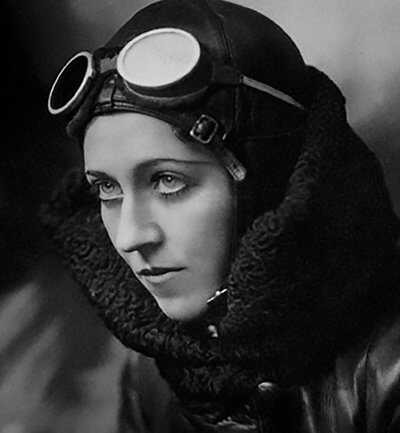


Adventuresses We Love – Amy Johnson Adventuress Amy Johnson started taking flying lessons at the London Aeroplane Club in 1928. Typical chauvinistic attitudes of the day meant she had to spend twice as much time in training as her male colleagues, but she did finally earn her pilot’s license in 1929. Later that year, she became the first British woman to qualify as an aircraft ground engineer. She then set her eyes on another goal – Australia. On May 5, 1930, with only 75 hours flying time under her belt, Johnson took off from Croydon in her deHavilland Gipsy Moth she’d named Jason. The flight would not be an easy one. Along the way, she’d battle sandstorms, monsoons, and blistering heat. As she sheltered from a sandstorm, packs of wild dogs got a little too close for comfort. Low on fuel, she made an emergency landing on a military parade ground in Pakistan, scattering the soldiers assembled there in the process. Finally, on May 24, she landed in Darwin, Northern Territory, becoming the first woman to fly solo from England to Australia. For this feat, she was awarded the Harmon Trophy, and a CBE by King George V. This was the first of several long-distance record flights for Johnson. In 1932 she flew from London to Cape Town, South Africa, beating the previous record (set by her husband,) by 11 hours. During World War II Johnson flew for the Air Transport Auxiliary, ferrying aircraft around England. On January 5, 1941, Adventuress Amy Johnson disappeared when the plane she was ferrying crashed into the Thames estuary. She was 37 years old; her body was never recovered. Jason is on permanent display at the Science Museum of London. Photo of Jason courtesy of the Science Museum of London, shared under the creative commons license.
26 notes
·
View notes
Text






1929 De Havilland DH60GM Gipsy Moth
One of the most famous models of aviation’s cradle era, the De Havilland Gipsy Moth occupies the same space in its category as the Model T Ford in automobiles—a dependably engineered, reliable vehicle, that brought its mode of transportation to more people than any other before it.
Hundreds of examples were built and were flown by several significant aviators of the era, including the noted British aviatrix Amy Johnson, who in 1930 became the first woman to fly solo from England to Australia in her Gipsy Moth, “Jason.”
Then-owner Cliff Lovell supplied this aircraft in early 1985 for the filming of Out of Africa, starring Meryl Streep and Robert Redford in the epic love story of the Danish countess Karen Blixen and British aviator Denys Finch-Hatton.
Courtesy: RM Sotheby's
Offered to benefit the creation of a new rhinoceros sanctuary in Central Kenya
#art#design#flying private#travels#luxury lifestyle#private jet#airplane#de havilland#gipsy moth#rm sotheby#kenya#out of africa#movies#amy johnson#meryl streep#robert redford#aviation#1929
21 notes
·
View notes
Note
k so i have a screenwriting project for drama, 30 min short film, i have like Some ideas but they're not good. you mention in my notes that in Romanian folk Christianity that God created Satan because he was lonely, that's compelling, could you share more? Could you give me research jumping off points?
Hi, sorry it took me a moment, but, again, craziest week in a while and it's not even because of DW.
But yeah, there appears to be a general idea of some kind of fraternal/co-creative relation between God and Satan in some folk Christian traditions. Arguably it's more the case of older myths getting a Christian makeover (sth sth Odin and Loki being blood brothers). Still, we end up with Satan and God hanging out amicably by the sea while bishops excommunicate each other over whether the Holy Spirit comes directly from the Father through the Son or simply from the Son.
The guy where I got this from was Mircea Eliade and he sort of applies jungian psychoanalysis of collective unconscious to religion. The specific essay is available on Internet Archive (my beloved) on pages 78-124. It's titled Mephistopheles and the Androgyne or mystery of the whole. Just fair warning, Eliade was writing in the first half of the 20th century and some of his vocab may be... not on par with modern sensitivities especially on Tumblr? He's not intentionally insulting or anything, just uses words like "gipsi" or presents male and female as discrete opposites or his information may be more anecdotal than thoroughly researched. So just. fair warning. It's brilliant in terms of finding general stories and their interpretations, so I hope it will be useful.
Some good bits (sorry, no quotes, the pdf is not editable):
Romanians have God and Satan be brothers or Jesus and Satan both be children of God
Ethiopians have a Saint and Devil-Woman be siblings (he ends up praying to Jesus for strength to murder his sister)
Peoples of Altai have God create the Devil by spitting on the Waters after exclaiming "If only I had a brother, I would make the World!". Then Satan suggests they be brothers and create tWorld together, but God answers "We will not be brothers but companions"
Romani of Transylvania have God be "unhappy alone" and admitting They don't know how to create the World, hence creating the Devil
Finnish version has God ask Their reflection in Waters how to create the World
Bulgarians dead ass have God see their shadow and tell it "Get up, comrade!" Satan then asks God to split thr Universe between them
Bottom line: knowing that this is the shit I've been into since I was a teenager, imagine what finding thoschei and especially tensimm did to my brain.
#always happtmy to infodump#mircea eliade#philosophy in doctor who#thoschei#yes i'm tagging this as those pathetic morons archetypes manifest in many forms
20 notes
·
View notes
Text
Angsty Maleigh aus in solidarity for the ones who like to chase catharsis reading a fanfic:
A year after Raleigh died during Pitfall, a woman reaches the PPDC, claiming her child is also Yancy's child and she wants Raleigh to take care of her because she doesn't want the kid. Mako adopts her.
Mako pod got lost within the anteverse and Raleigh didn't know until he woke up alone on the ocean, the lone survivor of the last jaeger fight.
Everyone knows the "anyone can fall" speech when Raleigh gave his oxygen supply to Mako and sent her away and safe from the anteverse. What no one knows is that within the drift, he let her know how he really wished could have been their future. That's the reason why Mako couldn't let go of his dead body over the escape-pod.
Going into the anteverse changes both Mako and Raleigh DNA. Newt, who acts as their doctor for all that time, is in fact creating a way for the precursors to take complete control of their bodies through their new kaiju genetics. It doesn't work as good on Mako, because she almost didn't have contact with the anteverse, but Raleigh begs her to kill him before they can use him to hurt anyone.
Mako goes on a comma after the drift test due the stress level of the memory. Pentecost has to pilot with Raleigh to defeat Otachi and Leatherback. They manage to save Crimson Typhoon and Striker, but not Cherno. Then, given the fact Pentecost goes critical and Herc is hurt, Raleigh has to pilot Gipsy with Chuck and Crimson plays defense. After all, Raleigh manages to save Chuck and go back to beg beside Mako's bed to her to wake up, the world is saved, Mako please forgive me, Stacker needs you, Mako listen to me--
After defeating Otachi on the sky, Mako and Raleigh share childhood memories before inevitably dying from the fall they can't stop anymore.
Mako wishes the kaijus were still there, if only because Raleigh is gone and she cannot avenge him anymore. Just live with her anger and her decisions. It's not like Raleigh tried to warn her about life... except he did.
Raleigh is the ghost that haunts every drift, looking for a chance to deliver one last message to Mako.
#pacific rim#pacrim#pacific rim 2013#pacrim 2013#raleigh becket#mako mori#maleigh#mako x raleigh#raleigh x mako
37 notes
·
View notes
Photo

A Jewish woman's attire from Debdou, Morocco, 1940s.
Chemise: cotton, smock-stitched embroidery with artificial silk and cotton thread
Breast panel: Linen and silk; chain-stitched embroidery with fabric-covered and couched-metal thread; cotton, wool thread machine-embroidery
Skirt (saya): ndustrially printed mixed wool, machine-made metal ribbon thread
The Jewish attire of Debdu, a town close to the Algerian border, combined elements of local rural dress, the urban styles of Jewish women in Morocco’s coastal towns, and, surprisingly, European folk costumes. The embroidery of the chemise is reminiscent of traditional European needlework, while the skirt, with its unique cut and vibrant colors, recalls the skirts worn by Gipsy women throughout Europe, who would also layer two or three skirts over a wide under-skirt. The breast panel appears to be a remnant of the style of the "Great Dress," whose lavish gold-threaded embroidery adorned the garments of urban Jewish woman.
38 notes
·
View notes
Text


D’ALTON, Helen [SHEA, Mary Ellen] (b South Terrace, Cork, c 1850; d 5 Curlew Street, Horsleydown, London 16 March 1893)
'One of the purest contraltos to which the sister isle ever gave birth' (The Standard, 1874).
Irish mezzo-soprano who found success as a ballad singer in the 1870s and 1880s.
Mary Ellen Shea was born in Cork, the daughter of John Shea, Esq., JP (b St John’s, Newfoundland 2 July 1803; d St Anne’s Hill, Blarney, Cork 9 October 1858), a merchant, magistrate and sometime mayor of Cork, and his wife Mary Agnes née Corbett (m 21 April 1836). Shea and his father-in-law, Dan Corbett ‘of South Mall, Cork), were leading lights in the organization of Cork’s National Exhibition of 1852, and Corbett was also known locally as a ‘jovial’ amateur actor and vocalist.
Mrs Shea ‘of Buckingham Place’ gave birth to a son, Henry John Francis on 14 June 1837, another on 24 May 1842, another on 18 July 1843, lost an Edward C (‘fourth son’) 5 October 1844 aged 2 1/2 … but doesn’t seem to have gone to the press with the birth of her ‘?only’ daughter.
Miss Shea studied singing with Mrs Charlotte [Sims] Reeves, and came out, for what seems to have been the first time, under the name of Mlle Hélène D’Alton (an improbable, but Irish high-society, surname), at an Ash Wednesday Concert at Drury Lane, 10 February 1869. She gave ‘Il segreto’, ‘O Rest in the Lord’ and joined the Doria sisters in the Athalie music.

Later in the season (31 July), she sang at the Crystal Palace, alongside Christine Nilsson, Clarice Sinico, Vernon Rigby and Foli, and was favourably noticed as ‘a young lady with a very pleasing contralto voice who sang touchingly the devotional air ‘O Lord, Thou hast searched me out’ from The Woman of Samaria and ‘Gentle troubadour’. The Morning Post confirmed ‘[she] ‘sang her two airs most beautifully. She has a remarkably touching quality of voice and her style is polished and confident; her voice, a mezzo-soprano of unusual clearness, travelled to the extremity of the transept with brilliant effect’.
Mlle D’Alton was engaged to appear at George Wood’s Saturday Evening Concerts at Exeter Hall in the new year, alongside Reeves, Santley, Foli and Mlles Sinico and Monbelli (‘The Gipsies Home’, Barnett’s ‘Old Familiar Friend’), after which she accompanied Santley, Mlle Sinico and another pupil of Mrs Reeves, Annie Edmonds, to Ireland (‘the Santley concerts’) and on 17 February 1870 made her first professional appearance in her home town (‘The Gipsies' Home’, Levey’s ‘Baby Mine’ and ‘Come Home, My Sailor Boy’, Blumenthal’s ‘When we are parted’, ‘Sainted Mother’ with Miss Edmonds). The reviews paid homage to her late father, and Ireland confirmed: ‘This young lady has a voice of great richness, uncommon compass and fine free tone. She sings with judgement, proves a good education, and excited a genuine admiration. She is likely to be very successful.’ ‘She always sings with truth, has admirable restraint, never exaggerates, and is sure to please’.

Back in London, Miss Helen D’Alton was billed with another young Mrs-Reeves-trained vocalist, the Scottish Jane Allan Stephen, in Sims Reeves’s Benefit concert (18 March), and over the following seasons, the said Miss D’Alton would appear, on frequent occasions, on concert bills in which Reeves was starred, both in London and in the provinces.
In between, she appeared at the Crystal Palace (14 May 1870) with the stars of the Italian opera, at the Glasgow Saturday Evening Concerts (‘Scenes of youth’, ‘Rich are rare were the jewels’, ‘Looking Back’), and made a single Ash Wednesday appearance at the Boosey Ballad Concerts (22 February 1871, ‘The Blind Girl’s Dream’ with ‘genuine feeling and expression’, Hawes’s ‘I’ll speak of thee’ and ‘O’er shepherd’s pipe’ with Santley). She gave her ‘Blind Girl’s Dream’, alongside Reeves and Santley, at Leicester, and, on 29 April 1871, she sang the title-role, alongside Mme Lemmens-Sherrington, Reeves and Patey, in Roeckel’s cantata The Fair Rosamund at the Crystal Palace and, the following year, his The Sea Maidens ('Maiden Muriel'). At Mr Austin’s concert she sang ‘I dreamed I was in heaven’ from Naaman, and she ventured wholly into oratorio with a Messiah with the National Choral Society, the Rossini Stabat Mater at the Covent Garden proms, an Israel in Egypt with Reeves at the Sacred Harmonic Society and in Carter’s Evangeline at the Albert Hall.

The oratorio experience was evidently not wholly convincing. Over the years that followed, Miss D’Alton would appear, on occasion, in oratorio – from The Messiah (‘scarcely seemed equal to the contralto music’, Manchester, 'scarcely powerful enough for so large a hall' Birmingham) to The Light of the World and The Prodigal Son (Manchester, 7 February 1874), Judas Maccabeus at Bristol, Jephtha/Last Judgement at Cardiff -- in the provinces, but her frequent London engagements were almost entirely in concert, where her evident speciality was modern ballad music. Pieces such as Mme Sainton-Dolby’s ‘He thinks I do not love him’, Sullivan’s ‘Golden Days’, The Distant Shore’, Looking back' and ‘Will He Come?’, Odoardo Barri’s ‘Mizpah’, ‘Love’s Golden Past’ and ‘The Shadow of the Cross’, Virginia Gabriel’s ‘A Shadow’, Gounod’s ‘Oh that we two were maying’, ‘Meeting Again’ by Cotsford Dick or Charles Salaman’s ‘Eva Tual’ and ‘Loved One’ were delivered in her ‘tuneful contralto voice and unobtrusive style’, her ‘excellent contralto voice and unaffected style’, to good effect. Very occasionally an operatic piece – ‘Ah! s’estinto’, 'Araby, dear Araby' or ‘Quando a te lieta’ – would appear alongside the new ballads, and the classic ones ('The Harp that once through Tara's Halls, 'O, Erin my country', Samuel Lover’s ‘What will you do, love?’, 'John Anderson, my Jo', 'By the sad sea waves'), a little more frequently an item from oratorio (Hiller's 'Lord, whom my immortal soul'), but rarely did Miss D’Alton venture into the world of the dramatic. I spot her, in 1874, singing in a selection from The Bohemian Girl at the Albert Hall, in 1875, during a modest appearance at the Norwich Festival, as a late replacement, she sang in some pieces of a local operetta, The Science of Love, and in 1878 she took part in a concert performance of Il Trovatore at the Royal Aquarium.

Miss D’Alton, in fact, became quite a regular at the Royal Aquarium where, apart from ballads and the ephemeral operatic experience, she also sang several times in the Stabat Mater (alongside the fireworks and freak shows), and she became an equally familiar presence at the promenade concerts staged annually at the Theatre Royal, Covent Garden. She took part in these ‘proms’ as late as 1887. On several occasions, too, she appeared in the prestigious Boosey Ballad Concerts (‘My Love has gone a sailing’ by Molloy, Linley's ‘Primroses deck the bank's green side’, ‘The Bailiff’s Daughter of Islington’), but without becoming a regular participant.

For a number of years, the 'clever and popular young vocalist' went on the road with Sims Reeves, in varying concert party combinations, alongside Gertrude Cave-Ashton, Foli, Agnes Larkcom et al – and again with Edith Wynne – but her name appeared, it seemed, most frequently on the ballad sheet-music which flowed from the various publishers’ lists: Cowen’s ‘The Better Land’, 'Love and Duty' and ‘A Song and a Rose’, Molloy’s ‘The Old Street Lamp’, ‘The Harbour Bar’, Ignace Gibsone’s ‘The Missing Ship’, Roeckel’s ‘Poppies in the Corn’ and 'A Midnight Song', Stephen Adams’s ‘In heart we both are young’, ‘The Children of the City’ and ‘True Hearts’, ‘I cannot forget’, Blumenthal’s ‘The Old, Old Story’ and ‘Lucy Gray’, Moulton’s ‘Beware’ and ‘I love my love’, Fanning’s ‘Something sweet to tell you’, Campana’s ‘Her Faithful Heart’, Milton Wellings’s ‘Young love that slumbers’, Owen Hope’s ‘In Happier Days’, Caroline Lowthian’s ‘Gates of the West’, Malcolm Watson's 'A Winter Story', as an adjunct to Antoinette Sterling on ‘The Lost Chord’ and to Mme Sainton-Dolby on a number of songs, and, latterly, on the songs of Isidore de Lara ('The Garden of Sleep', 'Once and For Ever'). As late as 1889, Miss D’Alton appeared on the bills of the Monday pops, with a new song by Maude Valerie White.
By the middle of the 1880s, however, she was appearing much less in public and, apart from the Covent Garden proms, largely in charity concerts and on fashionable society programmes. By the time, in 1889 (14 August), that she became the wife of Mr Fallon Percy Wightwick MD MRCS LRCP MB, a well-known medical man, she was appearing only a handful of times a season.
Helen D’Alton’ died just a few years after her marriage, and her obituary insisted that she was ‘a few years ago a highly popular contralto vocalist’. Which was more or less true. ‘Tuneful contralto voice and unobtrusive style’ had probably described her better.
It also insisted that she was thirty-eight years of age. Which was not true at all.She (vocalist, aged 20) and widowed mamma (52) can be seen lodging in Salisbury Street, Westminster in 1871 …

#classical music#opera#music history#bel canto#composer#classical composer#aria#classical studies#maestro#chest voice#Helen D'Alton#mezzo-soprano#contralto#classical musician#classical musicians#classical history#opera history#history of music#history#historian of music#musician#musicians#diva#prima donna
5 notes
·
View notes
Text
Woodstock.
Woodstock, the most famous of the 1960s rock festivals, held on a farm property in Bethel, New York, August 15–18, 1969, at the end of the hippie movement. The hippie flower child look from the late 1960's carried over into the first half of the 1970's, in a non-restrictive bohemian silhouette with a heavy folksy influence. Arts and crafts had a huge impact on fashion during this time including tie-dye, batik, knitwear, crochet and macrame.
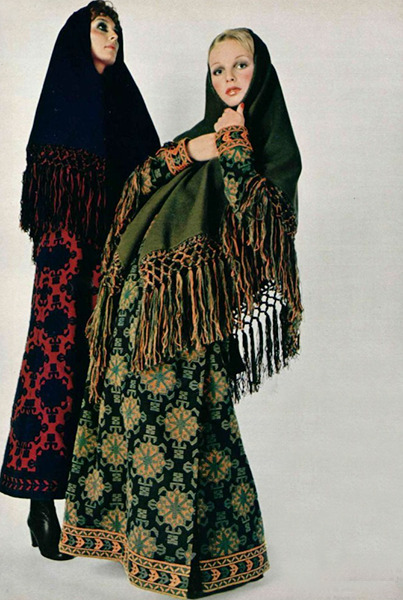
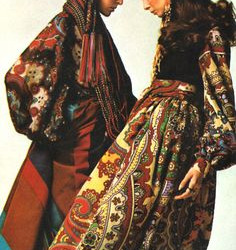
1970s Gunne Sax dresses.
Gunne Sax's aesthetic has been described as feminine, nostalgic, Victorian, old world and romantic. Though the brand is now closely associated with formal and bridal wear, its origins date back to late '60s San Francisco. In 1969, San Francisco boutique Gunne Sax needed a house designer. Enter Jessica McClintock, an elementary school teacher with a life-long interest in fashion. When a friend told McClintock of the opening at Gunne Sax, she applied immediately. McClintock was hired despite her lack of formal training in fashion design or clothing manufacture. Herself and designer Laura Ashley popularized the prairie dress phenomenon.
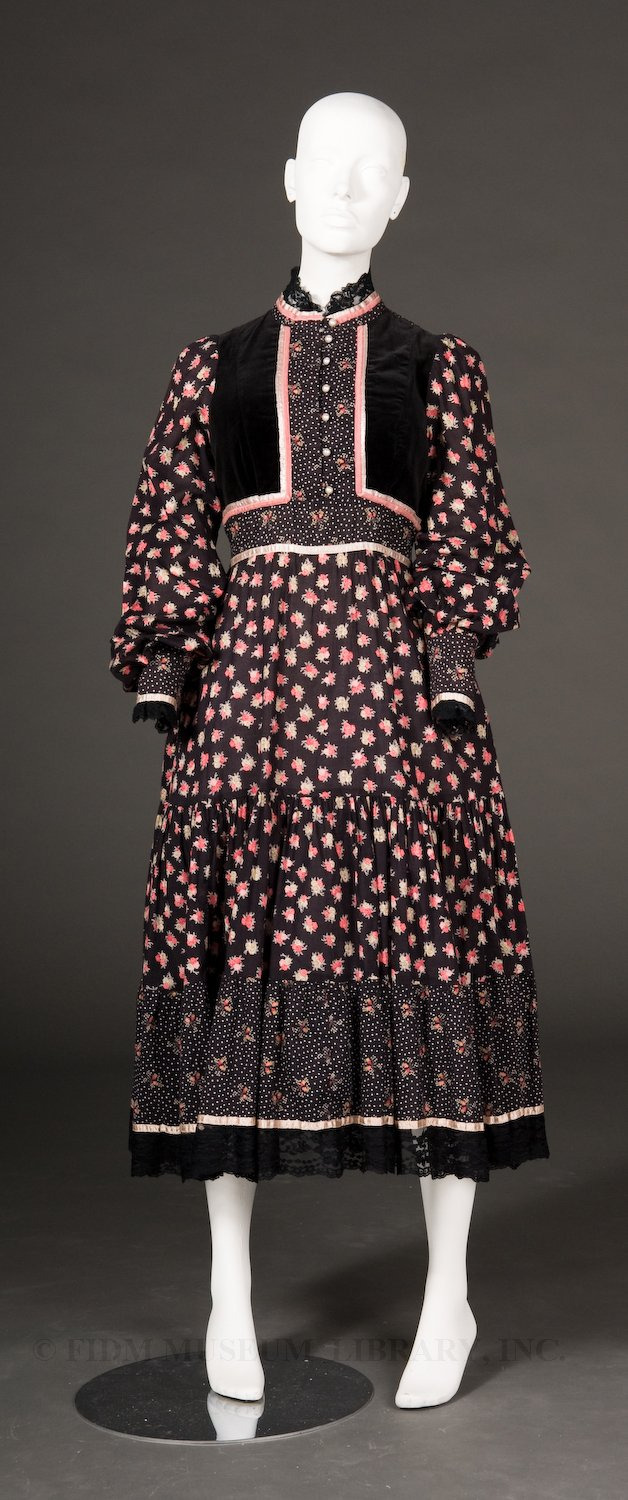

Sometimes referred to as Granny or prairie dresses, a typical Gunne Sax dress of the early 1970s featured a banded Empire waist and a long maxi-skirt. Lace trim, high collars and long sleeves evoked an amalgam of past eras and created an overall impression of demure femininity.
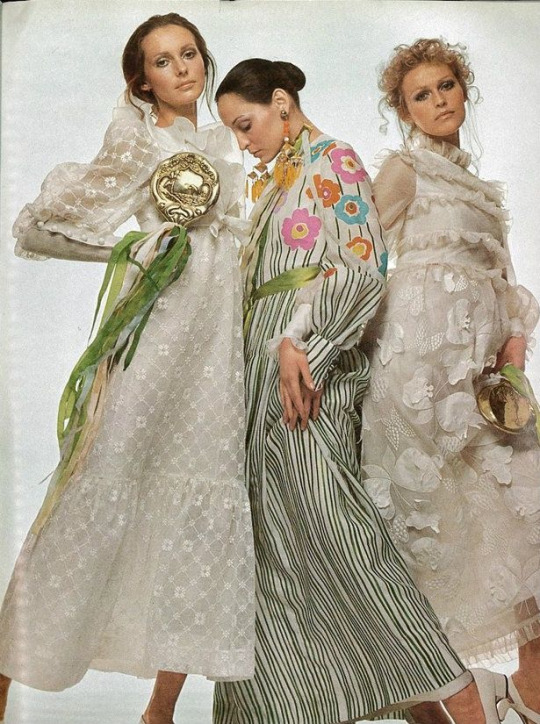
Vogue Italia March 1970.
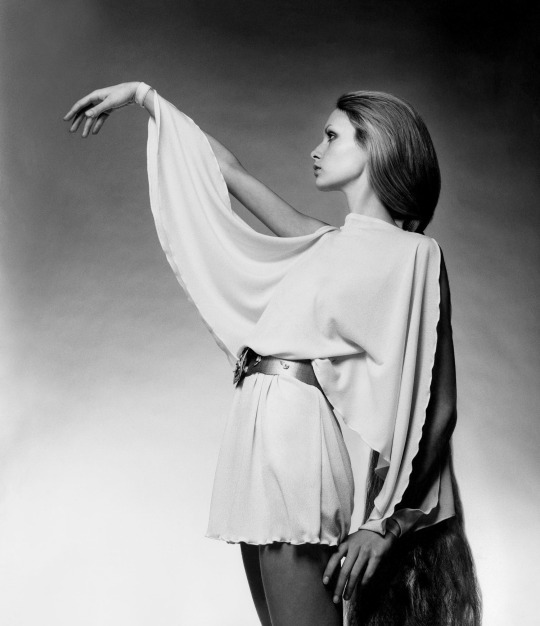
Twiggy for Vogue 1970
Thea Porter, Godmother of Bohemian Cheque.
Thea Porter, who is credited with bringing the bohemian look to London catwalks. Although Thea Porter is not as famous a name as Mary Quant or Laura Ashley, her influence on the look of her era is just as potent. Her loose, draped shapes and fabrics helped create the style of stars such as Faye Dunaway and Elizabeth Taylor in the 1970s, and they have since become forever entangled with the idea of rock-star self-indulgence. She celebrated ethnic styles in Indian style prints, free flowing breezy gauzy tent dresses and wide legged pants.
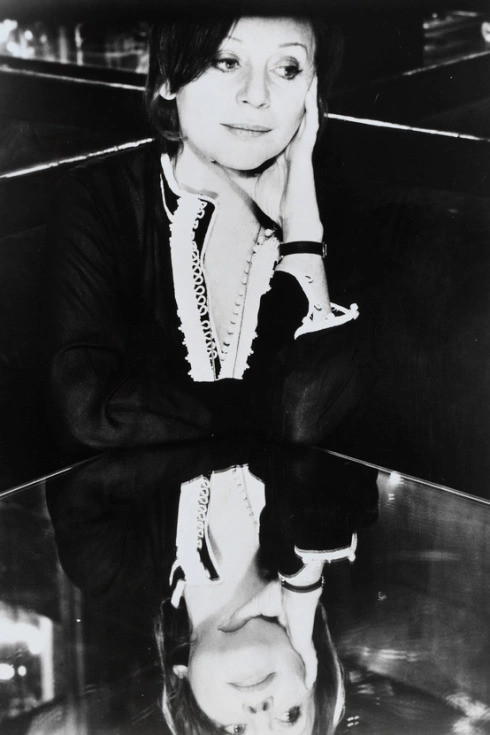
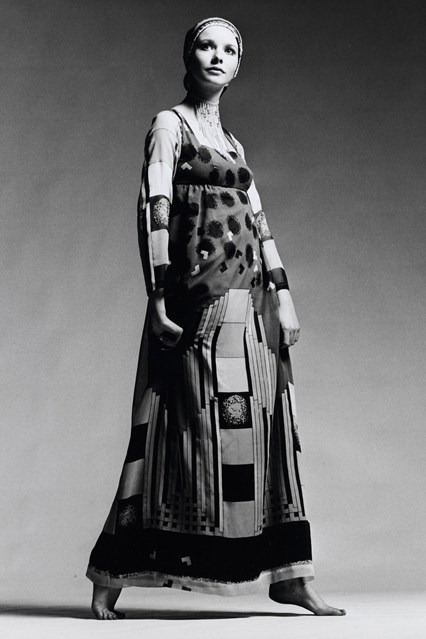

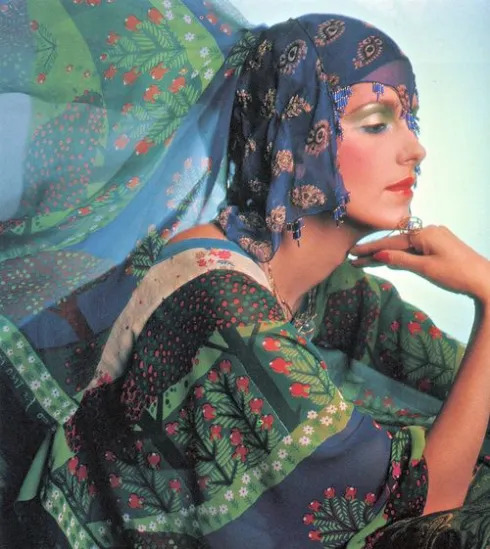
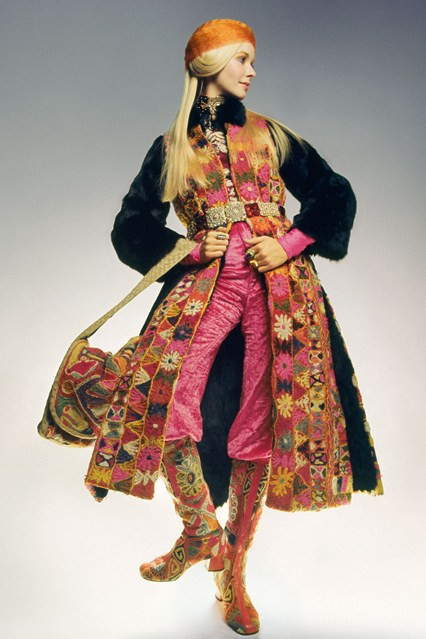
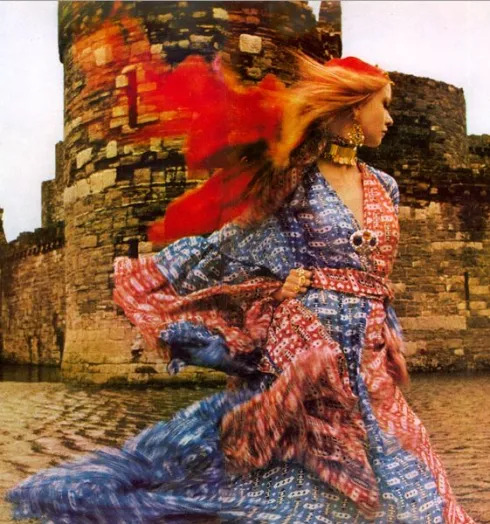
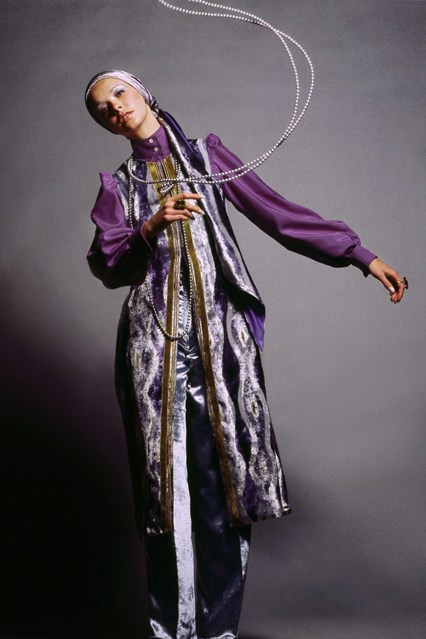
Porter's seven signature looks: the Abaya & Kaftan; the Gipsy dress; the Fraye dress; the Brocade-panel dress; the Wrap-over dress; the Chazara jacket, and the Sirwal skirt, as well as important fashion photography from the pages of Vogue, Harper's Bazaar and Women's Wear.
Changing skirt sizes.
This was the year of the changing hemline. There is no longer one length for one woman, but a whole wardrobe of lengths from which to choose. Mini, regular, midi and maxi length. Both emerald and bottle green were popular colours of the 1970s along with rust, wine red, purple, orange, and brown.
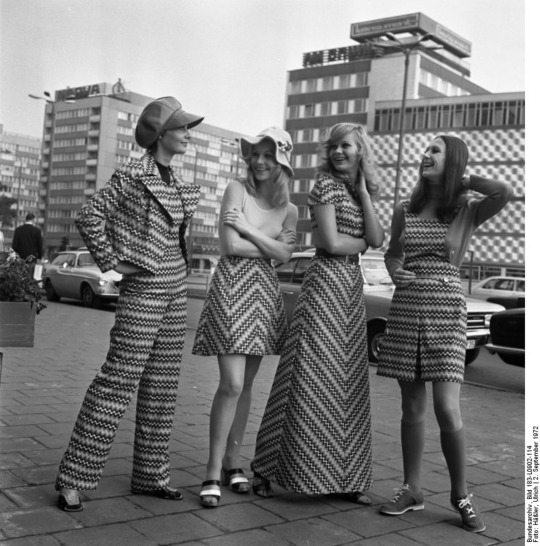
Tom Wolfe called the 1970s the "me decade" Across the land, Americans seemed determined to escape from the wars and social movements of the previous decade. Disillusionment with national and global action led many to look inward and find solace in discovering more about themselves. Women demanded respect as equal partners, and began to emerge into the work place. As women asserted themselves economically, socially, and politically, the idea of remaining trapped in an unhappy marriage became less and less appealing. Consequently, the divorce rate soared. An 1974 book entitled the courage to divorce encouraged individuals to put their own happiness above that of their spouses and children.
Every rule of fashion was shattered in the 1970s. Lapels, ties, and collars, reached record widths. The polyester leisure suit, available in a palette of citrus and pastel colors, was extremely popular among young males. The jacket, pants, and vest were often worn with an open collar to display thick necklace chains nestled in exposed chest hair. A senses of masculine style emerged in the film 'Annie Hall' which created a sensation with Diane Keaton wearing a fitted vest with a collard white shirt and men's neckties.
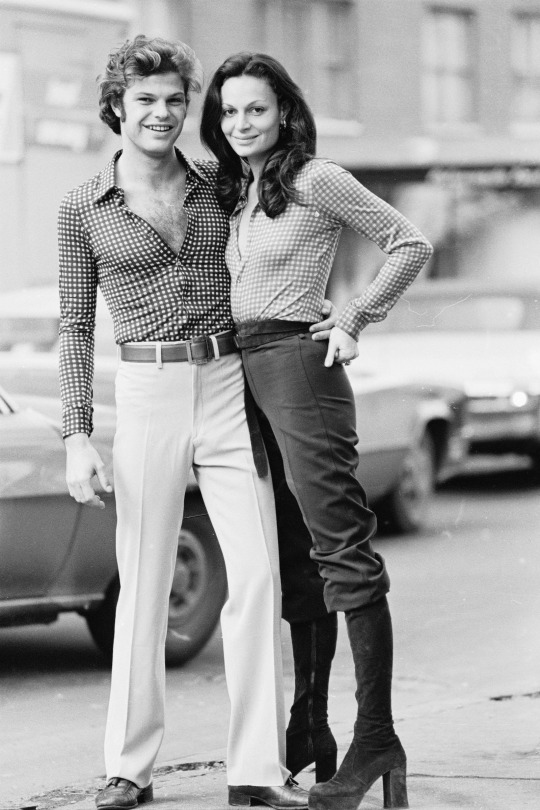

7 notes
·
View notes
Note
Hi Cherry! Just out of curiosity, are you a black woman yourself? Me, I'm a male Spanish gipsy (gitano) living in Sweden. Please don't hate me😁!
Hello! Yes, I am a Black woman from the States🥰
2 notes
·
View notes
Text

Tzigane (Gipsy Woman) - Thomas Couture
11 notes
·
View notes
